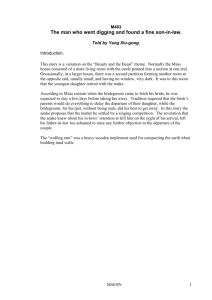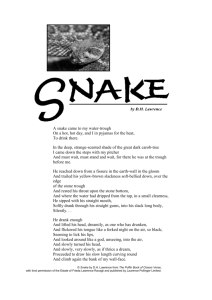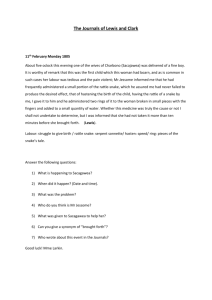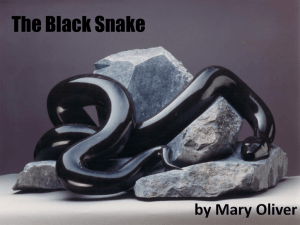Interrupting the Big Sleep
advertisement
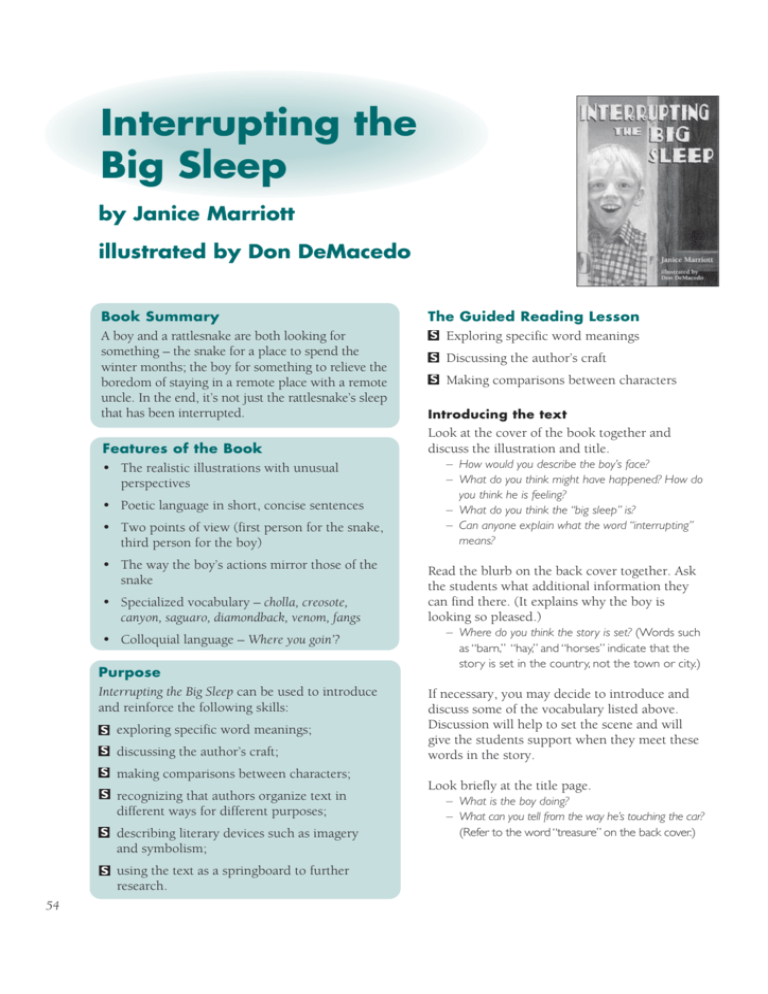
Interrupting the Big Sleep by Janice Marriott illustrated by Don DeMacedo Book Summary A boy and a rattlesnake are both looking for something – the snake for a place to spend the winter months; the boy for something to relieve the boredom of staying in a remote place with a remote uncle. In the end, it’s not just the rattlesnake’s sleep that has been interrupted. Features of the Book • The realistic illustrations with unusual perspectives • Poetic language in short, concise sentences • Two points of view (first person for the snake, third person for the boy) • The way the boy’s actions mirror those of the snake • Specialized vocabulary – cholla, creosote, canyon, saguaro, diamondback, venom, fangs • Colloquial language – Where you goin’? Purpose Interrupting the Big Sleep can be used to introduce and reinforce the following skills: S exploring specific word meanings; S discussing the author’s craft; S making comparisons between characters; S recognizing that authors organize text in different ways for different purposes; S describing literary devices such as imagery and symbolism; S using the text as a springboard to further research. 54 The Guided Reading Lesson S Exploring specific word meanings S Discussing the author’s craft S Making comparisons between characters Introducing the text Look at the cover of the book together and discuss the illustration and title. – How would you describe the boy’s face? – What do you think might have happened? How do you think he is feeling? – What do you think the “big sleep” is? – Can anyone explain what the word “interrupting” means? Read the blurb on the back cover together. Ask the students what additional information they can find there. (It explains why the boy is looking so pleased.) – Where do you think the story is set? (Words such as “barn,” “hay,” and “horses” indicate that the story is set in the country, not the town or city.) If necessary, you may decide to introduce and discuss some of the vocabulary listed above. Discussion will help to set the scene and will give the students support when they meet these words in the story. Look briefly at the title page. – What is the boy doing? – What can you tell from the way he’s touching the car? (Refer to the word “treasure” on the back cover.) Reading and discussing the text Ask a student to read the text on page 3 aloud. – Who or what is the narrator? – Why would they want to peel off their skin? – Does the illustration help you make a prediction? When the students have worked out that the narrator is some kind of animal perhaps a lizard or a snake, ask them to read the rest of chapter 1 independently. As the students read, they could note down any facts about the animal. When they have finished reading, write up the information that they have found. This could include: doesn’t like the cold; is venomous; sheds its skin; is a rattlesnake. – Why do you think there are no clues about the snake on the front and back covers? – Did the author and illustrator do this on purpose? – Did you expect the story to be told by a snake? Ask the students to read the first page of chapter 2. – What do you notice? (The narrator has changed.) – How is this part of the story the same as that on page three? – What has the author done? Ask the students to find the phrases that are the same in both chapters. Revisiting the Text The suggested activities below can be used immediately after the guided reading lesson if appropriate or could be taken as a mini-lesson at a later time. S Recognizing that authors organize text in different ways for different purposes This story has a very unusual organization. Ask the students to explain how it is different from a standard narrative (there are two points of view; the story is written like a poem; the snake, the boy, and the uncle are often described in the same way). – Why do you think the author wrote the story in this way? (to give two points of view; to create more tension) S Describing literary devices such as imagery and symbolism After the students have finished reading and have had the chance to think about and discuss the many themes, ask them to consider the title again. – What do you think “the big sleep” is? Does it only refer to the snake’s sleep? Look again at the text at the top of the last page together. Ask someone to read it aloud. – How is the uncle like the snake? – Who has interrupted the uncle’s big sleep? S Using the text as a springboard to further The students can now read the rest of the story independently. You could point out that the chapters of the book are narrated alternately from the boy’s and the snake’s points of view. As the students read, note any difficulties that they may be having and give support where needed. research Encourage the students to find out more about the diamondback rattlesnake and its habitat. – When you have finished reading, find some examples of treasure for the boy and treasure for the snake. The students could use the blackline master on page 82 to record the similarities between the boy and the snake. – Why does the writer keep comparing the boy and the snake? – How does the writer convey the image of the snake throughout the story? Discuss the ways the uncle is like the snake. – How does the writer make them seem similar? 55



